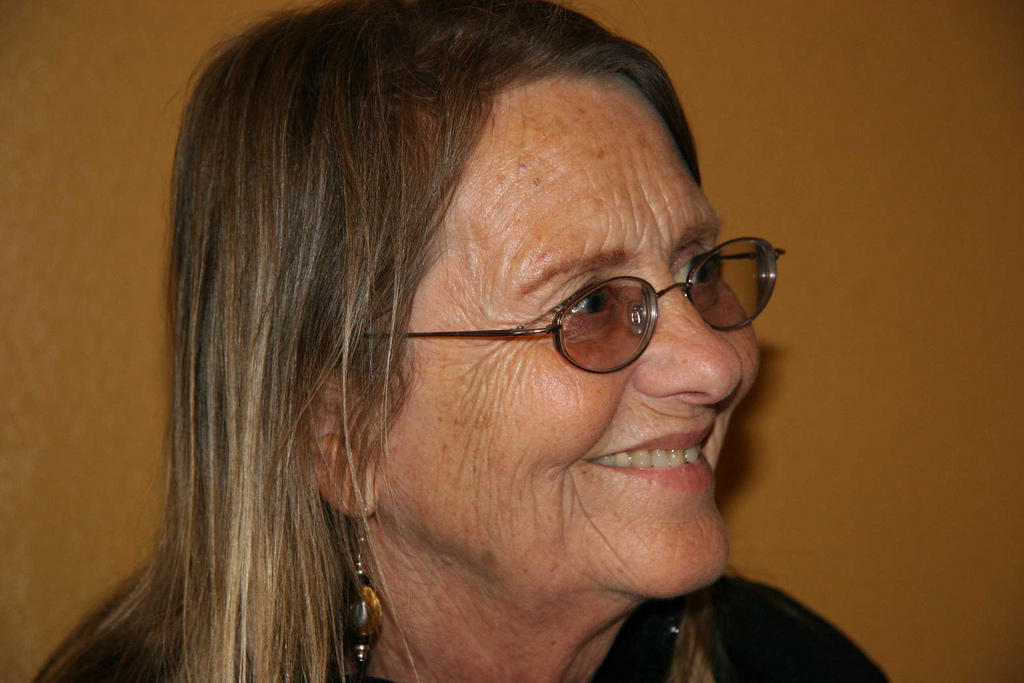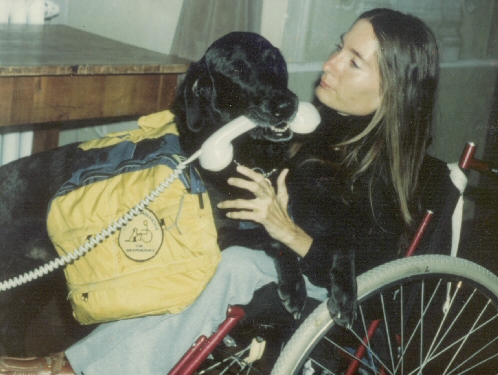Bonita Bergin: ‘I was passionate. I knew it was the right thing to do. And so all of those naysayers just rolled off my back, and I just kept looking for a way to do it. And I think that’s what changes the world—this belief, right or wrong, naïve or not.’ (Photo: ©All rights reserved by La Voz Bilingual Newspaper)Going To The Dogs
As the founder of Canine Companions for Independence and a professor of Canine Studies at Bergin University for Canine Studies, Bonita Bergin is proving naysayers wrong and changing lives for the better
By Duncan Strauss
Host, ‘Talking Animals,’ at NPR affiliate station WMNF-FM, Tampa, Florida; online at www.talkinganimals.netIt’s hard not to be struck by the way the early years of Dr. Bonita Bergin’s career saga parallel those of the four scrappy lads launching a band in Dublin in the mid-‘70s or the two brainy PhD students devising a search engine in Menlo Park, CA in the mid-‘90s—to pick just two examples.
Bergin didn’t start U2 or Google, of course, but the pioneering entity she created has also generated world-wide impact (she did so around the same time the Irish quartet began), and it required U2/Google-like unwavering persistence to realize that vision, often in the face of formidable challenges and a chorus of naysayers.
In 1975, she invented the concept of the service dog to assist people with disabilities that limit their mobility, and not long after, founded Canine Companions for Independence (CCI), the first non-profit organization to train and place service dogs.
The 2009 graduating class of Bergin University of Canine StudiesBack then, Bergin explained in an April 18 interview on Talking Animals, she was a teacher with international experience pursuing a graduate degree, and found her inspiration for the service dog idea in different animals she’d seen in some of the countries where she’d been teaching.
“I was in a Masters program,” she recalled, “and I was sitting there listening to people talk about what they would do for people with disabilities and how they would help them. And I kept going back in my mind to the time I was teaching in Turkey or traveling through Katmandu, Pakistan, India, and I kept seeing all these people with disabilities getting out and about. Not nicely. Sometimes, they were crawling. But sometimes they were being helped by donkeys and burros.
“So I just sat there listening to [suggestions like] stainless steel on the walls of institutions being a better way to manage situations for people with disabilities, and nutritious meals, which did make sense, of course. But I kept going back to ‘Why aren’t these people out of the institutions and doing things for themselves? What can we do to change that? All of a sudden, I just went Dogs! Dogs could do it. Dogs could help them.’”
I asked Dr. Bergin—who insisted that I call her Bonnie—about that light bulb moment, and what sort of training or experience with dogs prompted her to give the donkey and burro idea a canine twist.
“As far as any formal dog training or any formal knowledge, I didn’t have any. All I can tell you is I saw the donkeys and burros helping, and I just somehow or another pictured dogs being able to help.
“It was just an idea. I went around asking people to help. I went to Guide Dogs, saying ‘This is an idea.’ Everyone told me it couldn’t be done, shouldn’t be done, it wouldn’t work, it was a bad idea. And stupidly—maybe naïve is a better word—sometimes might not be a bad thing, because I just kept trying. And I finally found someone, by the name of Kerry Knaus.”
Service dogs at Bergin UniversityKerrill “Kerry” Knaus was a then-19-year-old quadriplegic with muscular dystrophy, whom she encountered in what proved to be a serendipitous development (hardly the only one lacing the Bonnie Bergin saga), when Bergin was calling organizations involved with disabled people of various stripes, hoping to find someone with a disability who might be interested in road-testing her newfangled service dog idea.
All sorts of organizations had pooh-poohed her notion—she mentioned multiple times in the Talking Animals interview that Guide Dogs was dismissive at every turn—so, unsupported but undeterred, she had taken to this spate of cold-calling any relevant organizations she could think of. One day, she phoned a program called Community Resources For Independence, launched into her pitch, describing the idea and asking if there might be a disabled person amidst the program who might agree to have a dog help with day-to-day tasks. The woman who answered the phone said she’d be willing, and that was Kerry Knaus.
Bergin picked up the thread of the story in our conversation: “Kerry was severely disabled, in a wheelchair, and when her head fell forward, she couldn’t even lift it--she didn’t have enough muscle in her neck to lift her back up on on her shoulders. Someone had to actually put it back up there. She could lift very little weight in either hand. But she wanted to try, and she was a dynamo.
“And between the two of us, and a dog named Abdul, almost every single thing that service dogs are doing today—pulling open doors, pulling open refrigerator doors, getting in, getting food out of the refrigerator to bring to someone with a disability, turning lights on and off, picking up dropped items—all came from what she told me she needed.”
Service dogs for people with limited mobilityAs pivotal and productive as the Kerry Knaus/Bonnie Bergin collaboration was--and, really, the results that teaming ended up yielding have improved the lives of countless people across gigantic swaths of the globe for nearly four decades—there was one more crucial member of this pioneering team: the dog, Abdul.
In yet another instance of the serendipity that partly propels the Bonnie Bergin narrative, Abdul—the family canine that otherwise might’ve enjoyed a regular ol’ life of long walks and longer naps—was perfectly suited for the service dog experiment. “Someone had given my husband and me a Golden Retriever, and my husband had accidentally let the Golden Retriever breed with a neighbor’s Lab,” Bergin recalls, chuckling, “and we had a litter of puppies, and that’s where Abdul came from. So he was a Golden/Lab cross… I actually tried every breed in the book after that. Nothing worked as well as the Golden Retriever and the Lab. And, again, by chance, that happened to be the very first one I tried. And, therefore, was probably very much a part of the initial success.”
Notwithstanding the highly fortuitous match of purpose and pooch, Bergin sees Abdul as the MVP of this groundbreaking squad. “Abdul deserves tremendous credit,” she said. “He has not been honored for being the very, very first (service) dog and I think he should be. As should Kerry, because the two of them did remarkable things, in terms of moving the concept forward. Had they failed—had I failed—I don’t know what would have happened.”
Abdul the service dog with Kerrill ‘Kerry’ Knaus: ‘…the two of them did remarkable things.’What is clear in Bergin’s eminently modest recounting of this critical phase in the birth of the service dog concept as a life-changing enterprise is that all three members of this pioneering triad were teaching, and learning from, each other.
Back then, to hear Bergin tell it, she had the most to learn, claiming she didn’t know anything much about dogs beyond that she liked hanging out with them. (“I knew nothing, so let’s not assume I had any knowledge”), and had about comparable knowledge about the lives and needs of disabled folks.
“I didn’t even know what help was needed. I didn’t know enough about people with disabilities to even know what help was needed. And Kerry and I worked through all of that. The only way the dogs got trained, at the initial stages, was because I was a teacher. And as a teacher, I just used teaching methods.
As so often happens when a good idea drives up to the intersection of passion and persistence, it worked! Big time. It took a lot of trial and error, and traveling a fairly steep learning curve, but “once Abdul was trained, and people in the disabled community saw the dog working for Kerry, then I was getting a lot of people coming in and saying ‘Will you train a dog for me?’“It wasn’t long before she’d founded Canine Companions for Independence, which quickly took off, building on Bergin’s self-taught education in the service dog realm, and greatly magnifying not only the demand for trained dogs that followed the successful Bergin/Knaus/Abdul experiment, but also creating a comparable demand for her to teach people how to train the dogs. “I was torn because by that time, I was getting so many applications—it was a five-10 year waiting list. I couldn’t meet the applications. So it was like, Which one is my baby? Canine Companions or the service dog? And I opted for the service dog, and moved into education.”
Canine Companions’ Wounded Veterans Initiative, featuring Calvin and Service Dog ChesneyI’ll say. After leaving Canine Companions For Independence in 1991, she created the Assistance Dog Institute, which achieved status as a university in 2004, and since 2007, has been known as Bergin University of Canine Studies. Located in Northern California, Bergin University offers students the opportunity to earn certificates, associate and bachelor degrees. It also may be about the only institution of higher learning around where someone can pursue a Masters Degree in Canine Life Sciences.
President of the university that carries her name, Dr. Bergen made clear in the Talking Animals interview that she relishes teaching her students about various facets of canine thinking and behavior—and still marvels at what the dogs have taught her.
The journey of a Canine Companions for Independence Assistance Dog“The dog is such an amazing animal,” she gushed toward the end of our on-air conversation. “If I’ve learned anything in this 37 years, I have learned that the dog has a mind—a really strong, positive, cognitive mind that has a numbers sense, and knows time, and can identify amounts, and has expectations, and are surprised when those expectations aren’t met.
“In fact, we’re moving into something—we’ve been teaching dogs to read, and I actually wrote a book on that [Teach Your Dog To Read]. I think the next book I’ll be publishing will be about what we’re finding on the moral sense of a dog.”
She sounds every bit as jazzed about dogs, about exploring the capabilities of dogs, as she did when that maybe-dogs-can-help-disabled-people light bulb went off in 1975—maybe more so. And she’s informally incorporated that sort of zealous determination into the Bergin University curriculum.
“The thing that I did is, I was passionate,” she said. “I knew it was the right thing to do. And so all of those naysayers just rolled off my back, and I just kept looking for a way to do it. And I think that’s what changes the world—this belief, right or wrong, naïve or not.
“Such a powerful belief that something is the way to go. And what I tell my Masters’ students is ‘You’re in the program to change the world. And the only way you’re going to do it is if you come up with an idea that you’re passionate about.’ We try to promote that here at the University of Canine Studies, because I know now that it works.”
To hear the entire interview with Dr. Bergin, follow this link
Founder/Publisher/Editor: David McGee
Contributing Editors: Billy Altman, Laura Fissinger, Christopher Hill, Derk Richardson
Logo Design: John Mendelsohn (www.johnmendelsohn.com)
Website Design: Kieran McGee (www.kieranmcgee.com)
Staff Photographers: Audrey Harrod (Louisville, KY; www.flickr.com/audreyharrod), Alicia Zappier (New York)
E-mail: thebluegrassspecial@gmail.com
Mailing Address: David McGee, 201 W. 85 St.—5B, New York, NY 10024




